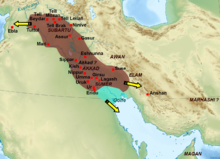List of kings of Akkad
| King of Akkad | |
|---|---|
 | |
| Details | |
| First monarch | Sargon |
| Last monarch | Shu-turul |
| Formation | c. 2334 BC |
| Abolition | c. 2154 BC 530 BC (King of Sumer and Akkad) |
| Appointer | Divine right, hereditary |
The king of Akkad (Akkadian: šar māt Akkadi, lit. 'king of the land of Akkad'[1]) was the ruler of the city of Akkad and its empire, in ancient Mesopotamia. In the 3rd millennium BC, from the reign of Sargon of Akkad to the reign of his great-grandson Shar-Kali-Sharri, the Akkadian Empire represented the dominant power in Mesopotamia and the first known great empire.
The empire would rapidly collapse following the rule of its first five kings, owing to internal instability and foreign invasion, probably resulting in Mesopotamia re-fracturing into independent city-states, but the power that Akkad had briefly exerted ensured that its prestige and legacy would be claimed by monarchs for centuries to come. Ur-Nammu of Ur, who founded the Neo-Sumerian Empire and reunified most of Mesopotamia, created the title "King of Sumer and Akkad" which would be used until the days of the Achaemenid Empire.
History[]

Although Sargon of Akkad is often referred to as the "founder" of Akkad, the city itself probably existed before his rule; a pre-Sargonic inscription refers to it by name and the name "Akkad" itself is not actually of the Akkadian language of Sargon and his successors.[2][3] Sargon's reign does however mark the transition of Akkad from a city-state into the first known great empire, with the Akkadian king ruling all Mesopotamia. His rise to power began with the defeat of the Sumerian king Lugal-zage-si, who had ruled Lower Mesopotamia from Uruk, and the conquest of his empire.[4] Through military campaigns, Sargon subjugated regions as far west as the Mediterranean and as far north as Assyria, which he boasted of in his inscriptions.[5]
Sargon's successors consolidated his vast realm and continued expanding the borders of the Akkadian Empire. Sargon's grandson and the fourth king of Akkad, Naram-Sin, brought the empire to its greatest extent and assumed a new title to illustrate his great power, King of the Four Quarters, which referenced the entire world. He was also the first king in Mesopotamia to be deified in his lifetime, being addressed as "the god of Akkad".[6][7]
Although at least seven kings would rule Akkad after him, the Akkadian Empire quickly collapsed after Naram-Sin's reign and prominent central authority under a single king would not be restored in Mesopotamia until the rise of the Neo-Sumerian Empire. It's likely that the region reverted to local governance under kings of city-states in the time between the two empires.[8] A major cause of this collapse was the invasion of Mesopotamia by a people referred to as the Gutians, who would be defeated and driven away by the founder of the Neo-Sumerian Empire, Ur-Nammu.[citation needed]
Kings of Akkad[]
Sargonic dynasty (c. 2334 – 2193 BC)[]
| # | Depiction | King | Reign (Middle Chronology) | Succession | Notes |
|---|---|---|---|---|---|
| 1 |  |
Sargon |